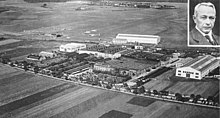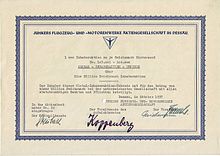Junkers aircraft and engine plants

The Junkers AG ( JFM ), based in Dessau was built in 1936 during the era of National Socialism from the fusion of aircraft factory Junkers AG Junkers engine GmbH . They were manufacturers of a large number of types of engines and aircraft, making them one of the most important armaments groups in the German Reich before and during the Second World War .
prehistory
The engines and aircraft manufactured by Junkers-Motorenbau and Junkers-Flugzeugwerk enjoyed an excellent national and international reputation, while their sole owner, Hugo Junkers, was considered politically unreliable by the Nazi rulers. Junkers was therefore forced in 1933 to transfer his privately held patents to the company and to surrender 51% of his shares to the Reich Aviation Ministry without compensation. At the same time, Junkers was banned from his works and was placed under house arrest in his summer residence in Bayrischzell . After Junkers' death in 1935, his widow and heiress Therese Junkers left the remaining shares to the Ministry of Aviation in return for a payment of around RM 30 million .
Under the leadership of the new Junkers Director General Heinrich Kopp Berg both companies were on July 5 in 1936, to Junkers AG merged .
Locations
In addition to the main factory in Dessau, which employed up to 40,000 people at its peak, JFM operated factories in Halle / S. , Graefenhainichen and Jüterbog . In the following period, further branches were opened (year of completion in brackets):
Aschersleben (May 1935), Bad Langensalza , Bernburg- Strenzfeld ( Bernburg plant , October 1937), Halberstadt (March 1935), Kassel- Bettenhausen (MWK, engine manufacturing plant in Kassel , August 1940), Köthen (MZK, engine manufacturing branch in Köthen , April 1935), Leopoldshall (March 1935), Magdeburg- Neue Neustadt (MZM, Motorenbau-Zweigwerk Magdeburg ), Merseburg , Muldenstein ( Muldenwerke AG ), Schönebeck (Elbe) , Zittau ( Zittwerke AG , March 1944).
During the war, underground locations were added, such as Heimkehle and Dora-Mittelbau concentration camp . In the course of the war, many forced laborers and concentration camp prisoners were employed, sometimes under inhumane conditions. From 1944 onwards, these included young people from Belarus who had been abducted in the " hay campaign ".
The construction department with around 80 employees was relocated from Dessau to Gernrode in the Hagental house during the war . According to information from the Dora plant , at the end of the war, shortly before the arrival of the Soviet Army, the Americans secured tons of construction documents there. The last Junkers general director Leo S. Rothe (* 1900, successor to Heinrich Koppenberg from 1941 ) experienced the overrun in Ballenstedt in the Harz Mountains, faced the Americans and was interned by them in the Oberursel camp near Frankfurt for six weeks and then released. In 1955 he became the first president of the Federal Association of the German Aviation Industry , was later a board member of Messerschmitt AG and died on September 11, 1975 in Bad Nauheim.
Products
In addition to aircraft types such as the Ju 52 that had been redesigned for military purposes and were already produced , a number of fighter aircraft such as the Ju 87 (" Stuka "), the Ju 88 and aircraft parts and engines were manufactured under the Junkers Jumo brand. In 1937 the first series-production jet engine Jumo 004 followed , which was later used in the Messerschmitt Me 262 , among others . In the Second World War , the Jumo 213 and Jumo 222 were among the best high-performance engines.
Post-war development
The JFM moved its headquarters to Munich in 1951 in order to manage the business assets and land located in the Federal Republic of Germany. At the beginning of the 1970s, JFM became part of the Daimler-Benz group.
See also
literature
- Wolfgang Wagner : Hugo Junkers aviation pioneer - his aircraft. (Die deutsche Luftfahrt, Volume 24) Bernard & Graefe Verlag, Bonn 1996, ISBN 3-7637-6112-8 .
- Holger Lorenz : Junkers license plate. Engineers between the Faust claim and the crucial question. Technical development and political change in the Junkers factories 1931 to 1961. Marienberg 2005, ISBN 3-931770-57-5 . Extract from pages 60 to 63 (PDF file; 300 kB)
- Dirk Schindelbeck : In the propaganda workshop. Everyday influencing in the Junkers aircraft works between 1942 and 1944. ed. Forum School Foundation. online (Schindelbeck, Forum 47) (PDF file; 950 kB)
- Helmut Bukowski , Manfred Griehl : Junkers planes 1933–1945 . Armament, testing, prototypes. Karl Müller, Erlangen 1999, ISBN 3-86070-867-8 .
Web links
- flugzeug-lorenz.de: “The History of Junkers Aircraft Works” by Holger Lorenz, accessed on December 26, 2010
- Biographies around Junkers ( Memento from February 6, 2012 in the Internet Archive )
- Early documents and newspaper articles about Junkers aircraft and engine plants in the 20th century press kit of the ZBW - Leibniz Information Center for Economics .
- A partial inventory of the company tradition "Junkers Flugzeug- und Motorenwerke Dessau" is in the Dessau department of the State Archives Saxony-Anhalt under [1]
Individual evidence
- ↑ History Traces blog entry, accessed September 27, 2012
- ↑ cf. Dietrich Wilde: In those Years Vol. 1, pp. 47–48, p. 74 Books on Demand 2011; Contemporary witness report
- ↑ Mittelbau private page, accessed September 27, 2012
- ↑ flugzeug-lorenz.de: "The History of Junkers Aircraft Works" by Holger Lorenz , accessed on September 27, 2012
Coordinates: 51 ° 49 ′ 56 ″ N , 12 ° 12 ′ 10 ″ E



